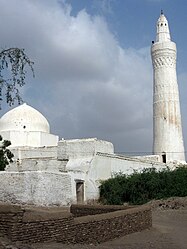Zabid
| Zabid | ||
|---|---|---|
|
|
||
| Coordinates | 14 ° 12 ′ N , 43 ° 19 ′ E | |
| Basic data | ||
| Country | Yemen | |
| al-Huddaida | ||
| ISO 3166-2 | YE-HU | |
| height | 110 m | |
| Residents | 21,567 (2004 census) | |
|
Zabid, Citadel Mosque al-Iskanderiya
|
||
Zabid ( Arabic زبيد, DMG Zabīd ) is a city in the coastal region of the Red Sea ( Tihama ) in Yemen . After Bayt al-Faqih is the largest city in the Tihama and after the southern Wadi Zabid named. The city is located in the center of an agricultural plain, about 100 kilometers southeast of the port city of al-Hudaida . The provincial city is home to around 21,500 residents.
history
Zabid was founded in 821 by the Ziyadid general Abdallah Ibn Ziyād . It was the only known planned city in Yemen and identified itself with a centrally located mosque, surrounded by the souq and the residential areas behind it. Four main axes led from the interior of the city to the city gates. Cotton and indigo were grown in the wadi of the same name , which in the 19th century led to a booming trade in textile products. The loam that was washed up by the floods was used for building brick houses.
The general also laid the foundation stone for the university system in the city and is responsible for outstanding academic achievements in the Arab world in the field of algebra . Zabid quickly gained a reputation as a city of scholars. In its heyday under the Rasulids , the university offered 5,000 places. To this day, the seat of the religious college of the Shafiʿites , one of the four Sunni schools of law ( madhhab ), lies in Zabid.
From that year 821 until 1018 it was the capital of the Ziyadid dynasty . After the assassination of the Ziyadid ruler, Zabid fell to the Najahid dynasty . It was their capital from 1022 to 1158. From the 13th to the 15th century, Zabid was the capital of Yemen under the Rasulids (1240–1420). With the conquest of the city by the Ottomans in 1538, the city began to decline. In the following years the craft migrated to Bayt al-Faqīh and the coffee trade passed Zabid by.
In 1763 the explorer Carsten Niebuhr visited the city.
Cityscape
The houses of the old town ( medina ) built around courtyards are located within the former city wall, from which the four city gates have been preserved . The Great Mosque in the west, the citadel and the former teaching building of the former university (al-Bayshiya) are worth seeing. Fired clay bricks are predominantly used for construction. The houses are low, at most one story. The facade is structured by an entrance door and - flanking it - two windows. There is a particular tendency towards ornaments and ornamental friezes . It is richly decorated with stucco. The facades are often whitewashed.
UNESCO World Heritage Site
Due to its historical and cultural importance, the city of Zabid was declared a World Heritage Site by UNESCO in 1993 . Since 2000 it has been on the Red List of World Heritage in Danger due to poor restoration and maintenance . The historical souq in the old town center is no longer used, many buildings have been replaced by modern concrete structures.
During military intervention in Yemen in 2015 were historic stucco building located outside the city on the Red Sea medieval coffee trading port destroyed while pro- to Saudi tribesmen and Huthi -Rebellen disputes provided near a shrine, is where reputed, on behalf of the biblical legendary figure of the Queen to have been built by Saba .
literature
- Salma Samar Damluji: The Valley of Mudbrick Architecture: Shibam, Tarim and Wadi Hadramaut. Garnet Publishing, Reading 1992, ISBN 978-1873938010
- Edward J. Keall: The Dynamics of Zabid and Its Hinterland: The Survey of a Town on the Tihamah Plain of North Yemen. In: World Archeology, Vol. 14, No. 3 (Islamic Archeology) February 1983, pp. 378-392
- Peter Wald: Harmony of settlement and landscape . In: Werner Daum: Yemen . Umschau, Frankfurt / Main 1987, pp. 388-391, ISBN 3-7016-2251-5
Web links
- Information from the Yemeni Ministry of Information (English) ( Memento from August 19, 2006 in the Internet Archive )
- Entry on the UNESCO World Heritage Center website ( English and French ).
- Status report 2006 of the World Heritage Committee (PDF; 742 kB), p. 75ff (English)
Individual evidence
- ↑ Census December 16, 2004
- ↑ Gerhard Heck, Manfred Wöbcke, Arabian Peninsula
- ↑ Horst Kopp (editor), Yemen geography (2005), Dr. Ludwig Reichert Verlag Wiesbaden, p. 101
- ↑ Josef Wiesehöfer, Stephan Conermann, Carsten Niebuhr (1733 - 1815) und seine Zeit, p. 163 f.
- ↑ a b UNESCO World Heritage Center: Historic Town of Zabid. Retrieved September 11, 2017 .
- ↑ History a casualty in Yemen's war as bombs smash ancient sites ( Memento from May 15, 2015 on WebCite ) (English). reuters.com, May 13, 2015, by Noah Browning and Mohammed Ghobari, archived from the original on May 15, 2015.
- ↑ UNESCO Director-General calls on all parties to protect Yemen's cultural heritage ( Memento from May 21, 2015 on WebCite ) (English). UNESCO World Heritage Convention, May 12, 2015, archived from the original on May 21, 2015.




